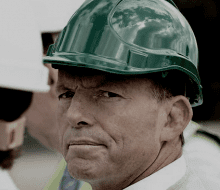The Coalition’s long-awaited white paper on developing northern Australia has outlined how it will harness the “bright growth prospects” of the resources and energy industry in the country’s north – an area it suggests could account for nearly 42 per cent of the Australian economy by 2040 – with barely a mention of renewables, two mentions of solar and, effectively, a single mention of wind.
The 200-page report, released by the Abbott government on Thursday morning, predicts resources will remain the dominant industry in the north – particularly the mining and export of gas and coal, of course – but on the subject of future energy generation and distribution to a part of Australia with the largest off-grid electricity demand, it becomes a lot more vague.
In fact, electricity generation and infrastructure gets a good deal less attention in the White Paper than it did in the Coalition’s original northern Australia 2030 “vision” document, published in September 2013 – around the same time a report was produced by AECOM for the Australian Trade Commission estimating Australia’s off-grid electricity market potential at approximately $A600 million, with around 213MW of renewable project opportunities in the short to medium term.
On broad terms, the policy document promised to “fast track growth in the north, the Commonwealth Government is providing a new $5 billion Northern Australian Infrastructure Facility to provide concessional loans for the construction of major infrastructure such as ports, roads, rail, pipelines, and electricity and water supply.”
To this extent, the Abbott government says it will also help promote northern business, trade and investment by “fostering greater innovation and leadership through dedicated R&D…” and by “…getting out of the way of business by providing a supportive regulatory and economic environment in which businesses operate.”
A “single point of entry” in Darwin will be established to remove barriers for investors in the northern jurisdictions, as will a One-Stop Shop for environmental approvals for development projects.
On the specifics of energy generation, the White Paper acknowledges that an increasing number of “isolated networks and stand-alone systems servicing remote communities and mining operations” could see electricity demand increase by around 52 per cent by 2018, and that 95 per cent of this new demand would most likely be met through “self-generation”, but has little to say about what that generation would be, and how the government might facilitate its development.
“For remote communities, commonalities and technical developments offer prospects for reducing costs, for example through the integration of renewable energy and diesel generation,” the report says.

On renewables, it makes a cursory – and some might say pretty cheeky – reference to the Renewable Energy Target, saying that the scheme means “more than 23 per cent of Australia’s electricity is expected to come from renewable sources by 2020, with renewables continuing to play an important ongoing role in the development of the north.”

Any mention of future renewable energy project development in the north is, however, restricted to projects either already underway – via ARENA, state governments, or academic institutions – or already approved. (Although the report does note that the government “supports actions that make it possible for the pastoral lease of the future to support more wide-ranging, high value food products, more tourism activities and possibly new emerging industries, such as renewable energy investments.” But there is no elaboration on this last point.)
Projects mentioned in the report include the state-government approved plans for WA’s first tidal energy power station – a 40MW facility in the Kimberley region that will be able to power 10,000-15,000 homes; the QUT’s Renewable Biocommodities Pilot Plant, that is converting cellulosic biomass into renewable transport fuels; and the over $55 million ARENA has invested across 30 remote NT communities through the Solar Energy Transformation Programme.
Another ARENA-funded “fringe-of-grid” project is also mentioned in the pink box below, alongside other sciencey/R&D agencies the Abbott government has cut funding from since coming into power.

The report then goes on to outline the importance of the proposed North/East Gas Interconnector, to connect with Australia’s eastern natural gas market, as an opportunity to test the gas market’s appetite to grow the industry.
“Such a link has the potential to contribute to a more efficient gas market through infrastructure that links markets, builds resilience and enables new gas resources to be developed,” it says.
Mention of “expanded energy networks” for Australia’s north is also made a bit further down in the report, but only in regard to “connecting the north’s gas resources with east coast markets, and delivering cost competitive energy to projects in the north.”
On energy exports, the report says Australia is “positioned as Asia’s energy supplier of choice from a balance of sources — natural gas, uranium, coal and next generation biofuels.”
Indeed, biofuels get their whole own bullet point in the Abbott government’s list of “aspirations for resources and energy”, with the anticipation of “large scale development of next generation biofuels using algae, capitalising on the north’s abundant land, water and sunshine.”
On coal, the report acknowledges a slow-down in coal production and investment, but stresses that, “with northern Australia holding in excess of 60 per cent of Australia’s economically demonstrated black coal reserves mostly in Queensland… ongoing exploration for coal and mine expansions will ensure the industry continues to meet demand from international markets.”

On LNG, the report notes that Western Australia’s Pilbara region currently produces 80 per cent of the nation’s liquid natural gas exports, a figure it expects to expand significantly by 2019 (see table below).











